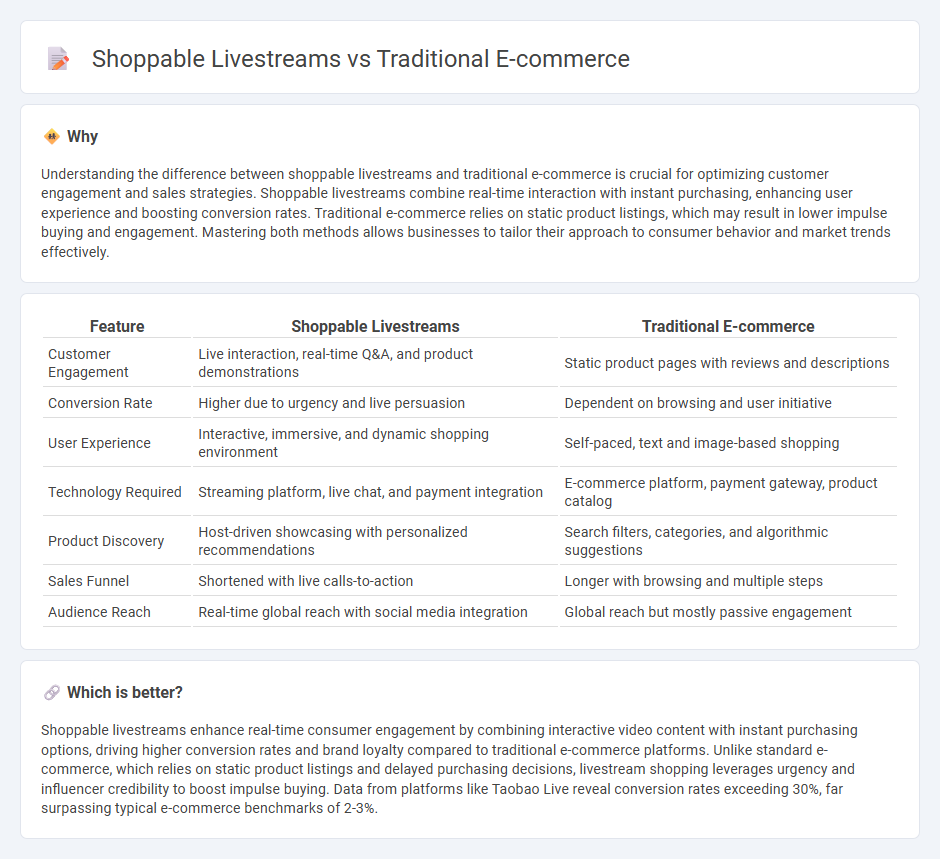
Shoppable livestreams integrate real-time video content with direct purchasing options, enhancing consumer engagement and immediacy in the shopping experience. Unlike traditional e-commerce platforms that rely on static product listings and delayed interactions, shoppable livestreams create dynamic, interactive environments fostering instant buying decisions. Explore how shoppable livestreams are revolutionizing online retail and transforming consumer behavior today.
Why it is important
Understanding the difference between shoppable livestreams and traditional e-commerce is crucial for optimizing customer engagement and sales strategies. Shoppable livestreams combine real-time interaction with instant purchasing, enhancing user experience and boosting conversion rates. Traditional e-commerce relies on static product listings, which may result in lower impulse buying and engagement. Mastering both methods allows businesses to tailor their approach to consumer behavior and market trends effectively.
Comparison Table
| Feature | Shoppable Livestreams | Traditional E-commerce |
|---|---|---|
| Customer Engagement | Live interaction, real-time Q&A, and product demonstrations | Static product pages with reviews and descriptions |
| Conversion Rate | Higher due to urgency and live persuasion | Dependent on browsing and user initiative |
| User Experience | Interactive, immersive, and dynamic shopping environment | Self-paced, text and image-based shopping |
| Technology Required | Streaming platform, live chat, and payment integration | E-commerce platform, payment gateway, product catalog |
| Product Discovery | Host-driven showcasing with personalized recommendations | Search filters, categories, and algorithmic suggestions |
| Sales Funnel | Shortened with live calls-to-action | Longer with browsing and multiple steps |
| Audience Reach | Real-time global reach with social media integration | Global reach but mostly passive engagement |
Which is better?
Shoppable livestreams enhance real-time consumer engagement by combining interactive video content with instant purchasing options, driving higher conversion rates and brand loyalty compared to traditional e-commerce platforms. Unlike standard e-commerce, which relies on static product listings and delayed purchasing decisions, livestream shopping leverages urgency and influencer credibility to boost impulse buying. Data from platforms like Taobao Live reveal conversion rates exceeding 30%, far surpassing typical e-commerce benchmarks of 2-3%.
Connection
Shoppable livestreams merge real-time interaction with instant purchasing, enhancing traditional e-commerce by integrating entertainment and direct sales channels. This synergy boosts consumer engagement, driving higher conversion rates and expanding market reach. Retailers leverage livestream platforms to showcase products dynamically, creating immersive shopping experiences that complement conventional online stores.
Key Terms
Transaction Model
Traditional e-commerce relies on a transactional model where customers browse products, add them to their cart, and complete the purchase through a website or app interface. Shoppable livestreams integrate live video content with instant buying options, enabling viewers to make purchases in real-time without leaving the stream, enhancing engagement and impulse buying. Explore how shoppable livestreams are revolutionizing transaction models and driving higher conversion rates.
Customer Engagement
Traditional e-commerce relies on static product pages and delayed customer interaction, often resulting in limited real-time engagement and lower conversion rates. Shoppable livestreams integrate live video with instant purchasing options, fostering dynamic audience interaction and enhancing customer engagement through immediate feedback, personalized experiences, and social proof. Discover how shoppable livestreams revolutionize customer engagement and drive higher sales by exploring their interactive features and benefits.
Real-time Interaction
Traditional e-commerce relies on static product listings and delayed customer feedback, limiting real-time interaction and engagement. Shoppable livestreams enable immediate communication between sellers and buyers through live chat and instant purchasing options, enhancing customer experience and boosting conversion rates. Explore how real-time interaction transforms online shopping by diving deeper into the benefits of shoppable livestreams.
Source and External Links
The Battle of Traditional Commerce, E-Commerce Who Wins? - Traditional commerce is based on physical storefronts, personal relationships, and local trust, but faces challenges adapting to the digital era as e-commerce offers global reach and convenience through the internet.
Difference between Traditional Commerce and E-commerce - Traditional commerce involves buying and selling products or services person-to-person without internet use, typically in physical markets, whereas e-commerce conducts these transactions electronically via the internet.
Difference Between Traditional Commerce and E-Commerce - Fastor - Traditional commerce depends on face-to-face interactions and physical stores, while e-commerce enables buying and selling online on a global scale without the need for a physical location.
 dowidth.com
dowidth.com